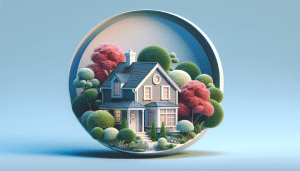Smart Ways You Can Boost Property Value
Megan Gray October 23, 2025
Explore proven strategies to enhance your property’s market value, from curb appeal upgrades to sustainable improvements. This guide covers high-impact real estate tips, renovation ideas, and ways homeowners can maximize return on investment without overextending budgets, making each step both rewarding and insightful.
Understanding What Drives Property Value
When thinking about real estate, one of the most common questions homeowners ask involves increasing property value. This topic is more nuanced than it seems. Several powerful factors can influence residential property appreciation, including local market demand, neighborhood features, and economic trends. Homeowners curious about maximizing returns often discover that understanding local zoning and historical pricing gives them an edge when making renovations or upgrades, potentially leading to increased equity and stronger negotiation power at the time of sale (https://www.consumerfinance.gov/owning-a-home/).
Location remains a leading factor in real estate valuation. Proximity to transit, reputable schools, and recreational amenities are vital. But in rapidly changing markets, savvy buyers also value walkability, safety, and future development prospects. Keeping an eye on city infrastructure plans or upcoming public amenities might reveal growth areas, prompting timely investments. Owners also benefit from researching comparable sales in their neighborhood, using publicly available databases and relying on professional appraisals as needed. These steps bring transparency and clarity to the valuation process.
Internal characteristics play a substantial role, too. Layout, square footage, and energy-efficient updates all impact appraised value. Homes with open floor plans, modernized kitchens, and updated bathrooms are particularly appealing to younger buyers, while features such as home offices or flexible room design have increased in relevance lately. Regular maintenance and attention to detail, like fixing leaks or replacing worn fixtures, help homeowners preserve and incrementally build overall market worth over time.
Simple Curb Appeal Upgrades Owners Discover
Curb appeal is one of the fastest and often most affordable tactics to improve home value. The immediate visual impression makes a lasting difference, drawing in prospective buyers or renters before they even step inside. Landscaping improvements are commonly cited as being cost-effective: planting native shrubs, refreshing mulch beds, or maintaining a green lawn can significantly shift perceptions. Homeowners can also update exterior paint or add stylish house numbers to offer a modern look while remaining budget-friendly (https://www.nahb.org/).
Front door upgrades and outdoor lighting bring added returns. Installing a new front door, or even repainting the current one in a welcoming shade, can make an entryway stand out on the street. Outdoor lighting not only adds style but heightens security—both factors buyers value highly. Small touches like pressure washing pathways or fixing broken fences create the impression of careful, responsible ownership. These efforts foster buyer trust and can yield higher offers, sometimes well above the typical investment cost.
It’s not just about first impressions. Consistent yard upkeep and thoughtful hardscaping—such as stone walkways or modern planters—bring a sense of order and permanence to the property. Modern buyers associate neat, well-lit homes with safety and comfort. In competitive markets, these small updates help set a home apart, increasing showings and accelerating offers. Over time, routine exterior improvements can cumulatively contribute to a notable increase in home value, underpinning any larger renovation strategy.
Popular Interior Renovations That Add Value
Not all renovations deliver equal value, but targeted interior improvements have been shown to drive a strong return on investment. Kitchen remodels—whether a full overhaul or cosmetic changes like new countertops and cabinet hardware—often lead lists of high-impact upgrades. These improvements appeal widely, as the kitchen remains a focal point in any home. Even modest updates, like upgrading appliances to energy-efficient models or refreshing old tile, can provide tangible appreciation benefits (https://www.huduser.gov/portal/pdredge/pdr-edge-trending-121319.html).
Bathrooms, next to kitchens, offer another high-leverage improvement area. Replacing outdated fixtures, adding fresh tile, or installing low-flow toilets modernize spaces while supporting sustainability goals. A clean, well-lit bathroom makes a remarkably positive impression during home tours. When considering larger changes, some owners add or reconfigure bathrooms, especially in multi-story homes, to attract families or those needing more privacy and convenience. The return on investment for these remodels is often reflected in both appraised value and buyer enthusiasm.
Flooring and natural light upgrades, like swapping worn carpet for hardwood or refinishing original floors, deliver both aesthetics and durability. Replacing aging windows with double-pane glass can help reduce energy costs while enhancing indoor comfort—features more buyers are searching for today. Adding features such as recessed lighting, neutral paint, or opening sightlines creates a modern, airy feel that lets buyers imagine personalizing the space. Involving a certified contractor or designer can ensure projects meet local codes and align with current buyer preferences.
Smart Home Technology and Energy Efficient Upgrades
The popularity of smart home technology continues to grow. Homeowners who invest in programmable thermostats, security cameras, or smart locks are creating appeal for tech-forward buyers. These upgrades provide both convenience and peace of mind—and can be highlighted as unique selling features during property marketing. Integrating voice assistants or remote-controlled light systems extends this convenience, drawing in younger generations very comfortable with integrated digital living (https://www.energy.gov/energysaver/energy-saver).
Energy-efficient upgrades deliver value in two ways: they lower ongoing costs and often qualify for local incentives or rebates. Upgrading insulation, installing Energy Star appliances, or investing in solar panels demonstrates forward-thinking stewardship. Energy audits, often subsidized by local governments or utilities, can help pinpoint the most effective improvements. Buyers increasingly ask about these features, knowing they’ll see cost savings over time. Well-documented upgrades can tip the decision in favor of your property during buyer comparison.
Eco-friendly materials, like sustainable bamboo flooring or low-VOC paints, are gaining traction as more people aim for healthier living environments. New building codes and consumer preferences have made green certifications a visible differentiator in the marketplace. Highlighting reduced carbon footprints, water-saving fixtures, or filtered air systems can make a listing stand out. Owners who choose sustainable improvements may also explore local, state, or federal tax incentives, adding financial motivation to environmental responsibility.
Financing Home Improvements and Understanding ROI
Boosting property value often comes down to budgeting wisely. Homeowners can explore various financing options, such as home equity lines of credit or personal loans, to fund renovations. Understanding which upgrades yield strong returns is critical—some projects offer higher appreciation relative to cost. Consulting local real estate data, talking with appraisers, and tracking current remodeling trends can help prioritize investments for the biggest impact (https://www.hud.gov/program_offices/housing/sfh/equity/heloc).
Calculating return on investment (ROI) for home improvements means considering both market shifts and individual goals. For example, a minor kitchen update is often recouped at a higher rate than a luxury pool addition. Knowing the average value uplift for each type of renovation—data often available from local or national realtor associations—helps prevent overcapitalization. Keeping receipts and obtaining before-and-after appraisals make the sales process transparent, which appeals to informed buyers and can facilitate smoother closings.
Some financing alternatives, like government-backed loans for energy efficiency or state-level grants, help lower borrowing costs for select improvements. These programs often have specific requirements, like using approved contractors or achieving certain energy outcomes, making research and planning essential. Sound financial planning gives homeowners flexibility, ensuring both immediate upgrades and long-term value gains are sustainable and aligned with household budgets. Wise allocation of resources supports predictable financial outcomes and satisfaction with the completed work.
Understanding Market Timing and Selling Strategies
Timing property upgrades or sales can influence both profitability and market appeal. Tracking seasonal real estate trends in your area is a powerful strategy; data often shows spring and early summer as peak transaction periods. Listing during high-demand months means more showings and competitive offers. Being aware of the market climate—such as shifts in mortgage rates or regional employment trends—lets owners plan renovations or listings most advantageously (https://www.nar.realtor/research-and-statistics/quick-real-estate-statistics).
Staging homes for sale is an often underestimated tactic. Professional stagers use furniture, lighting, and decor to highlight space and hide imperfections. Statistically, staged homes spend less time on the market and can achieve higher selling prices. Even when full staging isn’t possible, decluttering and depersonalizing the property allow visitors to imagine their own lives in each room. Clear, high-quality photos and virtual tours extend visibility to online audiences, driving more qualified interest from afar.
Working with a knowledgeable real estate agent helps sellers price their property accurately and implement a custom marketing plan for the local market. Experienced agents offer insights into buyer preferences and emerging trends, making it easier to time renovations or adjust listing strategies for the best outcome. Agents can also advise on pre-inspections or repairs, reducing surprises during negotiation and supporting a smooth, confident sales process.
References
1. Consumer Financial Protection Bureau. (n.d.). Buying a house. Retrieved from https://www.consumerfinance.gov/owning-a-home/
2. National Association of Home Builders. (n.d.). Home improvement. Retrieved from https://www.nahb.org/
3. U.S. Department of Housing and Urban Development. (2019). Home improvement and repair. Retrieved from https://www.huduser.gov/portal/pdredge/pdr-edge-trending-121319.html
4. U.S. Department of Energy. (n.d.). Energy saver guide. Retrieved from https://www.energy.gov/energysaver/energy-saver
5. U.S. Department of Housing and Urban Development. (n.d.). Home Equity Conversion Mortgage (HECM). Retrieved from https://www.hud.gov/program_offices/housing/sfh/equity/heloc
6. National Association of Realtors. (n.d.). Quick real estate statistics. Retrieved from https://www.nar.realtor/research-and-statistics/quick-real-estate-statistics








